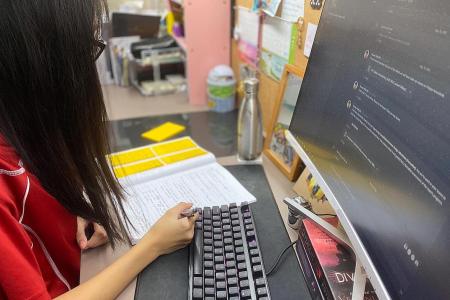Pupils and teachers adapting to home-based learning
While it cannot replicate the classroom experience, some educators have seen better participation, quality of work from students
While primary, secondary and pre-tertiary students returned to schools last week, those in polytechnic, the Singapore Institute of Technology (SIT) and the Singapore University of Technology and Design (SUTD) continue to have home-based learning (HBL) in phase one of the nation's reopening from the coronavirus circuit breaker.
It is vacation time for the other autonomous universities, and polytechnic students head back to campus mainly for practical and laboratory sessions.
For Ms Whitney Tan, 19, a third-year environmental design student at Temasek Polytechnic (TP), HBL came with the challenge of digitising her physical projects. "It's quite a steep learning curve. Consultations with our lecturers on our group's designs and drawings were harder through the screen due to a lack of good collaborative drawing sites," she said.
Some lecturers, like Ms Dora Chua, an Infocomm Security Management lecturer from Singapore Polytechnic, worked around certain modules that previously required physical interaction with equipment.
For instance, she used a software simulator instead of hardware sensors in a lab to teach in her Internet Of Things module.
MORE TIME
The polytechnics noted that while HBL has made communication between lecturers and students harder, with some students turning off cameras during tutorials, being at home has given students more time to focus on their work.
Ms Sheila Sim, a senior lecturer from TP's School of Business, said she saw better punctuality and higher attendance rates among students who had attendance issues in previous semesters, along with more assignments being turned in on time, and better quality of work.
Universities said their students and lecturers have adapted well to classes being moved online. A spokesman for the Singapore Management University (SMU) said: "Our faculty had to transform their lessons to an online format while preserving the interactivity of lessons as in a physical setting."
To achieve this, lecturers at SMU and SUTD adopted real-time polling and online quiz tools.
Dr Oka Kurniawan, a senior lecturer at SUTD's information systems technology and design department, said he has noticed some of his students ask more questions now because of the anonymity offered by the online question and answer platform.
However, Associate Professor Pearl Tan from SMU's school of accountancy said online learning cannot replace the traditional classroom experience because it is "two-dimensional". Likewise, Ms Joanna Tan, 21, an arts and social sciences student at the National University of Singapore, said online classes cannot replicate face-to-face lessons, especially for language modules that involve performing skits.
Mr Arif Hamizan, 23, an electrical engineering and information technology student at SIT, said he prefers HBL and hopes the arrangement will continue. This is because of the time and money he saves by not having to travel to school and eat out.
He added that since HBL was implemented, SIT has made recordings of online lectures available, which he finds helpful when he needs to revisit them.
Get The New Paper on your phone with the free TNP app. Download from the Apple App Store or Google Play Store now


